Associated Companies in over 175 towns in Great Britain and in Barbados, Bermuda. Canada, Ceylon, Guyana,
Hong Kong, Jamaica, Malaya, Malta, Singapore, South Africa, Trinidad and West Africa etc.
LONDON SW1Y 4LS
Rediffusion 1927-----------1987
The company started at Bush House with a staff of three and was known as Broadcast Relay Services or BRS
Two young engineers, Paul Adorian, Ralph Gabriel were the technical designers and assisting them was
W H Warman a production expert.
The earliest audio amplifiers were designed at this time. Rediffusion began distributing radio programs over small audio networks in England. As radios were expensive, the Rediffusion audio system was a much cheaper alternative.
As a wartime evacuee I was sent to Exeter where the house had a Rediffusion loudspeaker and volume control.
If there was an air raid warning it was announced over the audio link, (another early first for cable distribution)
1945. I joined the Experimental laboratory after an interview with a certain Bill Warman who was now works manager of the Rediffusion factory in Wandsworth.
( During the war Rediffusion was making Beacon transmitters used for guiding aircraft in distress to a suitable airstrip. There was also many other MOD contracts being manufactured, another famous communications receiver R1155A was built under licence. )
A large piece of floor space was covered by side panels of tarpaulin hiding a highly secret project which was hidden from the rest of the staff; it was given the code name of The Z Job!! We never discovered the proposed use of the Z job!. When the main lights of the factory dimmed we knew the Z job had been switched on.
The manufacturing side of Rediffusion was changed to Redifon later.
1946. Experimental Laboratory was led by Dr L E C Hughes, with a team of about 6 Engineers.
The first efforts of cable TV distribution were carried out, with some difficulty as the National TV service had been shut down during the war, so a simple monoscope was used as the signal input,for experimental purposes.
1946. National TV transmission was resumed, (this originated at Alexandria Palace North London.)
1947. The first cable transmission was tried in Maidstone using coaxial cable, using the existing 45 MHz signal. The cabling picked up the off air signal as well as the sent signal causing a ghost image which varied in intensity over the system. This idea was abandoned.
.
1950. The design centre was now known as Central Rediffusion Services (CRS) with the Head Office at Carlton House Regent Street London. Ralph Gabriel was the chief engineer of CRS. R I Kinross was now technical director of operations in Wandsworth.
It was decided to operate cable TV at a carrier frequency of 9.72MHz with upper sideband transmission , this system was given the name TDUK1. 100 Philips 9” tube size TV receivers were modified to accept an input frequency of 9.72 MHz . The audio signal was sent as baseband audio in traditional Rediffusion style.
New headend equipment was designed to transmit the signal and the town of Margate was selected for the field trial.The system worked well enough , although there were problems with patterning caused by powerful shortwave transmitters .
The normal TV signal in Margate was very poor and the Rediffusion signal was immediately seen to be superior and many customers were connected.
The BBC installed 5 powerful transmitters over the country this gave more scope for cable systems to be installed in area's which had a large amount of terraced housing.
1951. Rediffusion cabled the Festival of Great Britain with aluminium coaxial cable to provide a demonstration of Cable TV.
A two signal TV system was set up in Montreal using aluminium sheathed coaxial cable and distributed at 16&28 MHz respectively.
1953-1955. The Research division was split with a team of Engineers forming a design section, and a manufacturing division in Jersey. CRS was moved from Redifon Wandsworth to Coombe Lane Kingston
A second TV channel was imminent and this was launched in 1955 (the birth of Associated Rediffusion)
A new distribution service was designed known as TDUK2. This was a Tete-Beche signal. One program was transmitted at 4.95MHz upper sideband and the second was transmitted at 8.45MHz lower sideband.
Special TV receivers were manufactured by WRS (another arm of Rediffusion ). Later renamed Rediffusion Consumer Electronics (RCE)
The receiver frequency response was a Parabola shape with the two carrier frequencies at -6db with respect to the centre point.
The subscriber was supplied with a wall switch to select programms
Jersey also produced a two channel system called TDUK3 where the terminal unit(TV) had a switch fitted to enable program selection. This method carried two signals on one cable .The operating frequencies were 6.3 MHz lsb and the original TDUK1 signal 9.72MHz usb.
Some Rediffusion areas were able to produce an out of area ITV channel as an extra programme. This was allowed under existing rules regarding extra programme material.
1963. BBC2 began transmissions using CCIR system I (negative modulation 625 line definition and broadcast at UHF frequences.
A new type of receiver was designed to launch this program on the network. The front end had a crystal controlled oscillator to convert the signal to 38.9 MHz vision and 32.9 MHz audio. These IF 's were then demodulated to baseband audio and video. The audio signal was used in the conventional manner, the video signal was remodulated at 5.4MHz. More network cables had to be used to accommodate this extra signal.
1963----1970. By now transistors, integrated circuits were in use.
1968. All 4 terrestial channels began transmitting in colour.
From 1965 a new design of frequency changer was being designed. This had a crystal controlled oscillator at the input and a crystal controlled phaselocked loop at the output frequencies of 5.4 and 8.9 MHz respectively.
This unit was given the code FC100 At a typical aerial site 4 FC100's would be used with an FC100VA as a standby unit . The FC100VA had a commercial tuner fitted with AFC control,to provide back up for each channel.
There were several versions of the FC100 for worldwide use.
eg. FC100B CCIR system B
FC100G CCIR system G
FC100 Aus FOR Australia
FC 100N Exclusive design for Holland
FC100 U for the USA
FC100SA CCIR system I (same as UK ) but with front panel engraving in Afrikaan's and English
FC100 SO sound only for special use.
FC100K Updated version of FC100VA
Some versions also produced sound at RF ie, with vision at 8.9MHz, sound 2.9MHz.
Over the years many items of test gear had been designed for specific use on the cable network, to name a
few - Cable fault locator, Calibrated receiver, Handheld linesmans level indicator, Pulse and bargenerator, Sweep generator, and many others .
Many patents were granted. Rediffusion Research had its own patent officer at Coombe
1976. Rediffusion demonstrated a TV signal sent over 1 mile by means of a fibre optic cable running in parallel with the main vision trunk route at Hastings The demonstration was a success and comparison could be made between a signal sent over copper or fibre optics. This was thought to be a first for Rediffusion.
1980. It was realised that many other programmes would shortly be available
and a new transmission system was designed. This was known as System 8,
it used 5 coaxial cables each carrying 6 TV channels at VHF, this was
converted back to UHF at the subscriber connection.
1987. Research set the system up in Guildford for a field trial which was the
only franchise that Rediffusion had been given from the 12 franchises awarded.
Robert Maxwell had by now bought the company. Using a team of advisers from
an American company (Viacom) he decided that system 8 was not a viable
product. All of the staff based at Coombe were made redundant. System8
ceased to operate and the network was sold in turn to NTL who ran their own
broadband signal in its place. Most of the remaining branches now renamed
Metro TV, were eventually closed or sold off to other cable companies.
NTL and Telewest today come under the banner of Virgin Media
Cyril Hunt CEng MIET

Central Rediffusion Services
(Rediffusion Research)
Carlton House
Lower Regent Street

by: Cyril Hunt CEng MIET
The following composition by Cyril Hunt - CEng MIET looks back to the history of Redifusion with particular reference to Research and Development of the "wired vision" system over the years. Cyril Hunt worked with the company from 1945 - 1987 and was instrumental in much of the systems development over this long period.
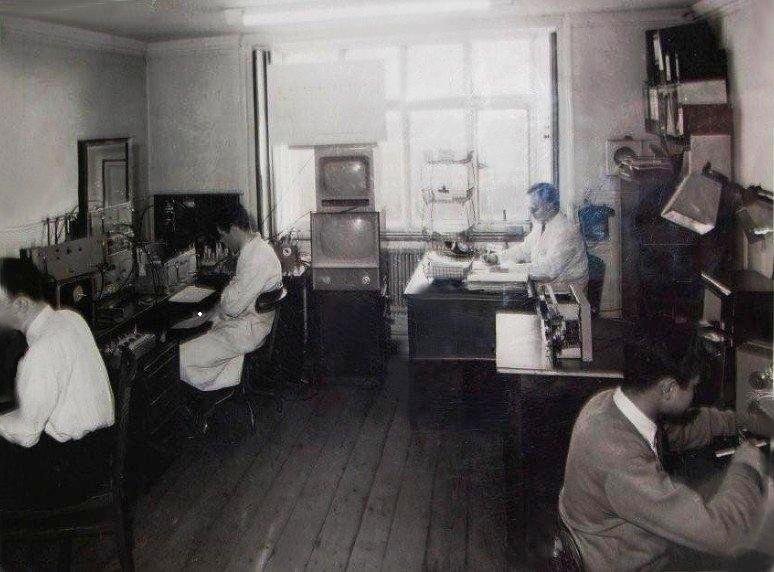 | Cyril 1958 |
|
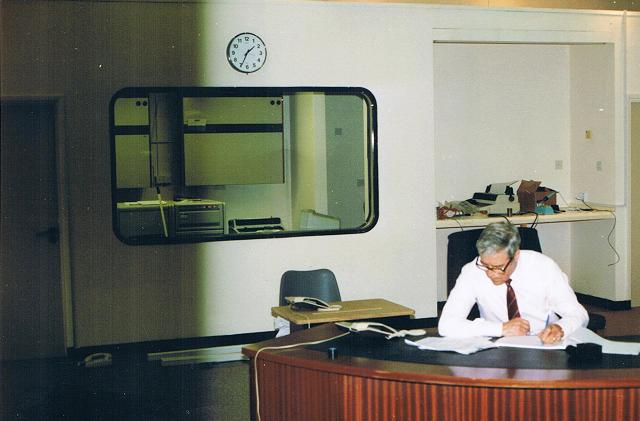 | Main Computer for driving the network. |
|
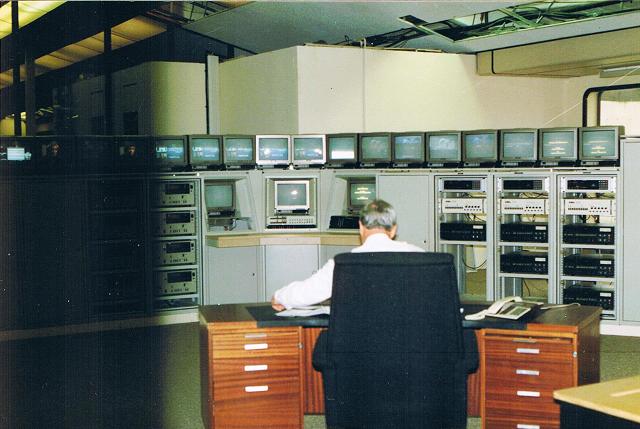 | Front view of the Headend. Each cabinet was filled with equipment. |
|
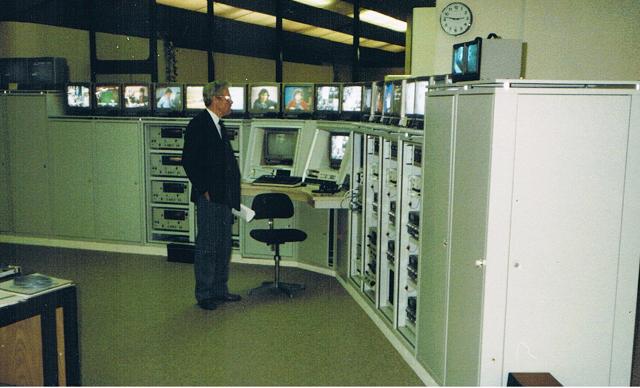 | Another view of the Headend equipment |
|
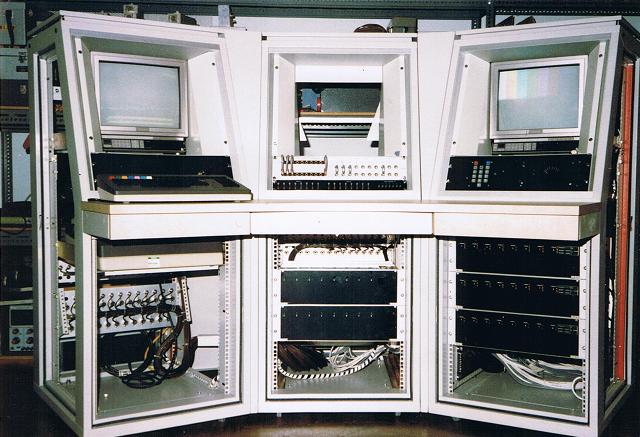 | The Control Desk |
|
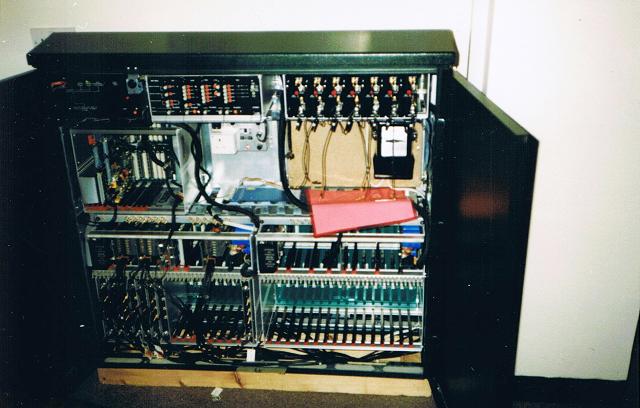 | Typical street kiosk with 7 repeaters. |
|
.JPG) | Writing a locally produced text page ( Programme Announcement ) |
|
.JPG) | Complex wiring inside cabinet |
|
.JPG) | Further view of cabinet wiring |
|
The following pictures illustrate Guilford "headend" in the summer of 1987 when System 8 was up and running.
Exception - picture 1 shows Cyril (left rear) at work at Coombe Lane in 1958
Double click for full size image
Double click below for full size image
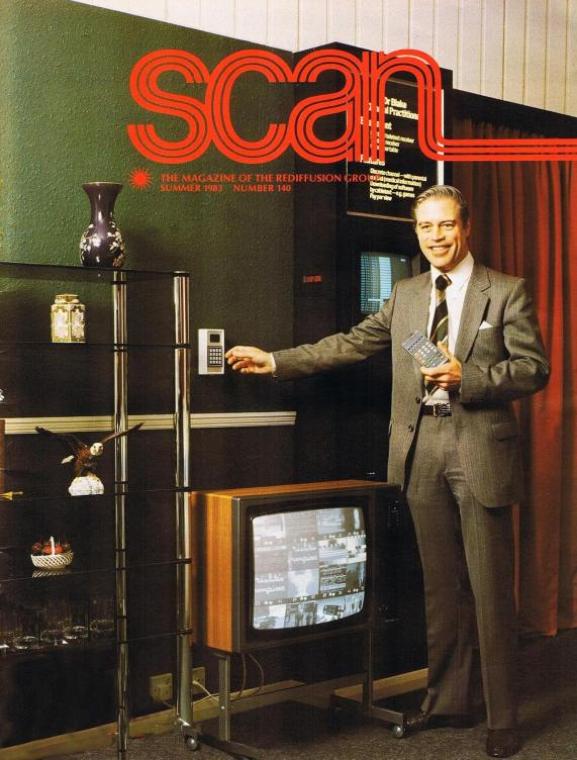 | Cyril Proudly Demonstrating System 8 Featured on The Front Cover Of Scan Magazine 1983 |
|



